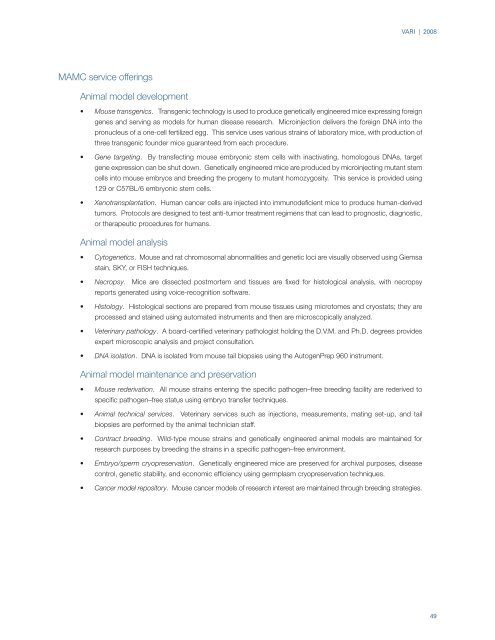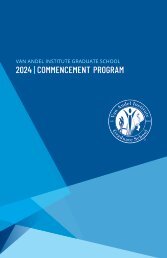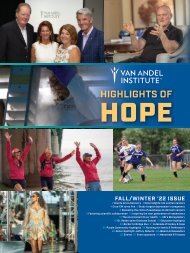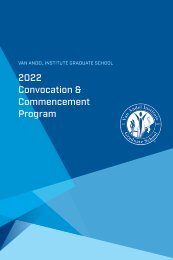2008 Scientific Report
You also want an ePaper? Increase the reach of your titles
YUMPU automatically turns print PDFs into web optimized ePapers that Google loves.
VARI | <strong>2008</strong><br />
MAMC service offerings<br />
Animal model development<br />
• Mouse transgenics. Transgenic technology is used to produce genetically engineered mice expressing foreign<br />
genes and serving as models for human disease research. Microinjection delivers the foreign DNA into the<br />
pronucleus of a one-cell fertilized egg. This service uses various strains of laboratory mice, with production of<br />
three transgenic founder mice guaranteed from each procedure.<br />
• Gene targeting. By transfecting mouse embryonic stem cells with inactivating, homologous DNAs, target<br />
gene expression can be shut down. Genetically engineered mice are produced by microinjecting mutant stem<br />
cells into mouse embryos and breeding the progeny to mutant homozygosity. This service is provided using<br />
129 or C57BL/6 embryonic stem cells.<br />
• Xenotransplantation. Human cancer cells are injected into immunodeficient mice to produce human-derived<br />
tumors. Protocols are designed to test anti-tumor treatment regimens that can lead to prognostic, diagnostic,<br />
or therapeutic procedures for humans.<br />
Animal model analysis<br />
• Cytogenetics. Mouse and rat chromosomal abnormalities and genetic loci are visually observed using Giemsa<br />
stain, SKY, or FISH techniques.<br />
• Necropsy. Mice are dissected postmortem and tissues are fixed for histological analysis, with necropsy<br />
reports generated using voice-recognition software.<br />
• Histology. Histological sections are prepared from mouse tissues using microtomes and cryostats; they are<br />
processed and stained using automated instruments and then are microscopically analyzed.<br />
• Veterinary pathology. A board-certified veterinary pathologist holding the D.V.M. and Ph.D. degrees provides<br />
expert microscopic analysis and project consultation.<br />
• DNA isolation. DNA is isolated from mouse tail biopsies using the AutogenPrep 960 instrument.<br />
Animal model maintenance and preservation<br />
• Mouse rederivation. All mouse strains entering the specific pathogen–free breeding facility are rederived to<br />
specific pathogen–free status using embryo transfer techniques.<br />
• Animal technical services. Veterinary services such as injections, measurements, mating set-up, and tail<br />
biopsies are performed by the animal technician staff.<br />
• Contract breeding. Wild-type mouse strains and genetically engineered animal models are maintained for<br />
research purposes by breeding the strains in a specific pathogen–free environment.<br />
• Embryo/sperm cryopreservation. Genetically engineered mice are preserved for archival purposes, disease<br />
control, genetic stability, and economic efficiency using germplasm cryopreservation techniques.<br />
• Cancer model repository. Mouse cancer models of research interest are maintained through breeding strategies.<br />
49

















